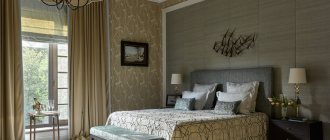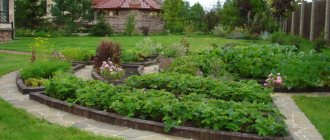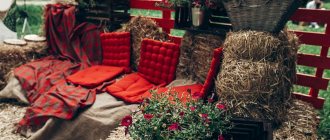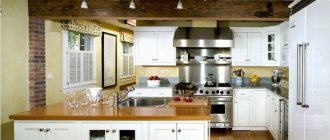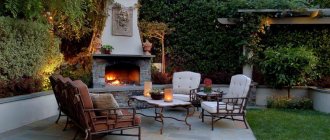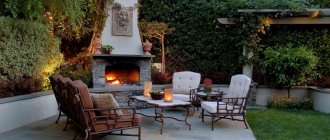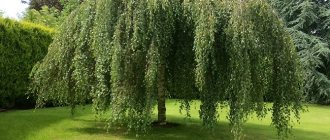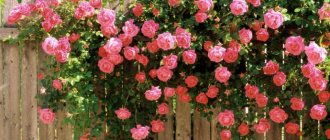Having become the happy owner of your own private house with a garden plot, you need to think about the correct layout of the main dacha elements, such as flower beds, a garden and a vegetable garden.
Let us dwell in more detail on the proper location and arrangement of the vegetable garden. In order for your future beds not only to produce a good harvest, but also to fit perfectly into the landscape of your site, you should take into account some nuances.
Artistic concept: choosing a style
The right garden starts with an idea. The style of the future garden is the starting point, the basis for further plans, calculations and the desired outcome: the opportunity to enjoy the beauty of the site without performing feats of labor. There are many ways to arrange your local area.
To choose the most suitable one, it is necessary to take into account the local climate, as well as take into account the topography of the site. It is also useful to know what characteristics a particular landscape style has and consider the cost of maintaining it. There are three popular areas of landscape art: regular, landscape and rock gardens. Other types of gardens (Japanese, modern, eco, minimalism, high-tech) require serious cash injections and constant care, so they are less common.
Each style has its own surroundings Source pinimg.com
Regular (aka classic or French)
Regular gardens initially adorned the surroundings of Versailles, so special requirements were placed on them: strict symmetry of layout, straight lines and geometric shapes of plantings. To maintain royal order, eliminating any hint of weeds, vigilant attention is necessary. The French style is expensive, both in construction and in maintenance.
French chic Source woodynody.com
Natural (aka landscape or English)
The complete opposite of the French classics. The style is based on the naturalness of forms. Free landscape, free, flowing lines, romance and complete fusion with nature. The work of human hands should not overshadow the beauty of flowers and trees, so they try to make paths with curves, and plants are planted in groups, lushly and slightly carelessly. An English garden, with its open layout, is easier to care for and easier to keep tidy than a regular one.
English carelessness Source dapurindonesia.web.id
Rocky (rock garden, rock garden, dry stream)
The rocky garden imitates mountain landscapes and comes in three types:
- Rock garden . To build a rock garden (alpine slide), you will need a hill. This can be a slope or hill of natural origin, or an artificially constructed rocky mound. It is preferable to choose a place for a rock garden in sunny, well-ventilated areas.
- Rockery . In order to plant a rockery, you do not need a hill or a hill - the plants are planted on a flat surface. Rockeries have a slight advantage - they can be placed anywhere, in the shade or on a sunny area.
Alpine inspired Source pinimg.com
- Dry stream . It can be a detail of a rocky wall, for example, combined with an alpine slide, or an independent original element of landscape design.
A rock garden, rock garden and dry stream are suitable to become the main accent of a very beautiful garden. The effectiveness of the compositions is determined not by the variety of stones and their quantity, but by the harmonious choice of rocks. It is recommended to select one or two types of natural stones, most often these are pebbles, blocks of granite, sandstone, and limestone. There is marble, basalt, slate, tuff.
The advantage of rock gardens is their ease of maintenance. To decorate them, ground cover plants, shrubs, perennial flowers and conifers are selected; the latter preferably in the form of dwarf varieties.
Dry stream Source pinimg.com
Lawn as a basic element of the landscape
The layout of a small plot must include space for a lawn. Shrubs can serve as a frame for it.
A good solution would be to line its perimeter with pebbles or paving slabs. A beautiful lawn is a comfortable place to relax and play.
What to remember when choosing a style
When comparing different styles, it is worth evaluating not only the external impression, but also the practical side. If your goal is a hassle-free garden, it's helpful to keep the following points in mind:
- Who will look after him and how often?.
If you do not have a personal gardener, and your area of interest lies far beyond gardening, it is worth considering the choice of plants. Leave rare and exotic species to the professionals. There is a huge range of beautiful flowers, trees and shrubs that are easy to care for.
- Keep yourself in check.
Beginning gardeners want everything at once, but it is important to measure their strengths and capabilities, and add plants gradually.
Picturesque view and minimal maintenance Source pinimg.com
- Don't forget about the location of utility networks.
Drainage, irrigation and lighting systems will require costs during arrangement, but will greatly simplify garden care in the future. For the design and installation of networks, it is better to contact a specialized company.
- Think about the cost of garden maintenance.
This is not only the consumption of water and electricity, but also, for example, tree pruning (if it is planned) - whether you do it yourself or invite a specialist.
- Landscaping a garden does not come without unplanned expenses..
Estimate the cost of improvement and multiply the amount by one and a half. The result will be a budget close to the real one.
A simple way to make your garden beautiful Source trevi-studio.ru
See also: Catalog of companies that specialize in landscape work
Arrangement nuances: how to visually expand the space
In addition to the residential building and auxiliary buildings, there are other objects that appear during the development of the site and then exist for many years. Before you put up a fence, plant trees and lay garden paths, you should think about every little detail; redoing a poorly laid path is a troublesome and costly task. After dividing the site into zones, you can begin to design them. The main way to change the perception of space is to divert attention from all kinds of boundaries and barriers.
Layout: simplifying the task
The point of the plan (or project) is to make garden arrangement as easy as possible. It will help save time and money, since you don’t have to navigate on the spot or decide according to your mood, which, as we know, often leads to mistakes and disappointments. The plan is drawn up in advance, before any excavation work begins and the first plants are purchased.
Supporters of the old school are more accustomed to sketching out a plan on paper; others can draw an electronic version using one of the design programs. In the latter case, it is not difficult to try several options for placing objects and zones in order to choose the optimal one. At this stage, making amendments and even changing the concept is much easier than when construction has begun. A well-planned plan includes the following details:
- Boundaries of the site, contours of the house and outbuildings.
- Trees and shrubs growing on the site.
- Boundaries of functional zones.
An example of a detailed layout Source pinimg.com
In the garden, it is necessary to think over a system of paths and paths with a covering that suits the style. The width of the main paths is planned to be at least a meter; for secondary and auxiliary paths, 60-70 cm is enough.
When the main details of the plan are drawn, we begin to draw smaller objects: flower beds, beds, a recreation area with a gazebo or barbecue, an artificial pond, an alpine slide, a fountain, a bench.
During planning, we must not forget about the shadow from buildings and trees. To properly plant shade- and sun-loving plants, identify sunny areas and those that are in the shade most of the day. It is also important to know the groundwater level and soil type. This will help you choose plants that suit these conditions.
If the area is uneven Source pinimg.com
Zoning: an important design tool
The zones are purely functional; they are applied after all present and future objects are marked on the plan. The number and size of zones varies widely; it all depends on the lifestyle of the owners.
Zones divide the territory into logical blocks that help you choose the right plants and make it easier to care for them. The following zones are present to varying degrees on the site:
- Entry . A purely functional area, which in different versions includes a gate, a driveway, a parking lot, and a garage.
- Front area . The business card of the site, the place from which the façade of the house can be seen. The front area allows you to evaluate the tastes of the owners, so it is decorated most carefully. Often it is combined with the entry zone.
Front area Source pinimg.com
- Economic zone . It is allocated for fruit trees, shrubs and beds. There may be several economic zones, for example, a vegetable garden in the far corner of the site, and fruit trees and raspberry bushes closer to the house.
- Rest zone . If the size of the plot allows, several places are organized for collective, quiet and active recreation. The center of the zone can be a barbecue area, a gazebo, a swimming pool, or a decorative pond with a bench on the shore.
- Playground . The sandbox, swing, and slide are placed so that they are within sight of adults.
Beautiful and practical Source pinimg.com
Pre-planning
The option when landscape design will be carried out on an undeveloped site is considered optimal, since there is no need to rebuild or relocate existing facilities. Initially, the owners will have to balance their dreams with reality and determine the buildings that they really need. The set of necessary facilities may vary from family to family; in most cases the following elements are included (in various combinations):
- Residential building, garage or parking lot.
- Outbuildings (shed, workshop).
- Buildings for recreation (sauna, gazebo).
- Technical structures (well, septic tank).
The landscape design of a small area is determined by the principle of zoning the territory, which allows you to competently manage the available square meters.
There are many graphic programs that allow you to competently plan a site Source seattlehelpers.org
Even a modest-sized suburban area can be turned into a comfortable and, importantly, functional place. During preliminary planning, the following design principles are taken into account:
- About 10% of the total area of the site is allocated for buildings
- The garden and vegetable garden (including a greenhouse or greenhouse) account for the maximum area, up to 75%.
- The recreation area, which includes a gazebo, flower garden and barbecue area, will occupy about 15%.
The size of the zones may vary depending on the preferences of the owners. Anyone who is not keen on growing organic vegetables, but loves relaxing with family and friends, can arrange a spacious recreation area with all the amenities. Anyone who appreciates the aesthetics of garden decor will plant most of the area with ornamental plants and install a stylish gazebo and fountain.
Small area - big opportunities Source yandex.ru
Choosing plants
If you get relaxation from digging in a flower bed, you will always have time to carefully care for capricious plants and exotics. If all you agree to do after planting is periodically water the green spaces, choose plants that will not require specialized care. In central Russia, the following principles for choosing plants will be useful:
- Coniferous plants can be used as the basis for building a garden . Thanks to conifers, the garden remains beautiful and elegant all four seasons of the year.
- If the location of the plot is sunny, this is initially good for growing fruit crops and a vegetable garden .
Conifers form volume Source mykaleidoscope.ru
Where to place greenhouses and greenhouses?
It's nice to please yourself with fresh vegetables from your own garden when the season is not yet open. To do this, you will need to build a structure with insulated soil - a greenhouse or greenhouse. You can buy a ready-made structure, or make it yourself from scrap materials.
Usually, an area of 100 m2 is enough for a greenhouse; here it is enough to plant 5-6 seedlings of each vegetable (tomatoes, cucumbers, bell peppers, zucchini). Additionally, you can sow greens. This is quite enough to satisfy the need for early vegetables.
Video description
About shrubs for hedges in the following video:
Conifers
When selecting plants, do not chase after new and exotic products. The basis of the garden should be local species, those very plants that require a minimum of care. Then you will be absolutely sure that they will not freeze in winter or burn in the summer sun. The following coniferous species grow well in the middle zone:
- All varieties of common spruce and prickly spruce (blue).
- All varieties of Scots pine and mountain pine.
- Korean firs , both natural (tall) and dwarf forms, with green or blue needles. Subalpine (mountain) firs.
- All varieties of western thuja with a rich color palette of needles (from bright green to bright yellow).
- European, Japanese, Korean larches weeping varieties.
Composition with conifers Source meredithcorp.io
Beautiful vegetable garden at the dacha: how to properly arrange the beds?
There are a lot of ideas for placing beds in the garden; examples can be seen in the photo below. But we recommend that you familiarize yourself with the tips for designing beds in the vegetable garden; thanks to them, the harvest will please you more:
- Place plantings with low plants from north to south;
- Level the soil before planting. If the soil has a slope, then plants are planted across the slope to increase the efficiency of irrigation;
- Try to make the beds the same in length and width (3-4 m in length, width no more than 45 cm). Firstly, it looks beautiful, and secondly, such a bed is convenient to treat from weeds.
- The shape of the beds can be any: circle, rectangle, square, trapezoid, wavy, etc. It is only important that it is easy for you to process them;
- The beds are made high and low: the advantage of high (bulk) beds is that they serve as additional protection from rodents;
- Study the material about the correct proximity of plants in the beds.
Video description
About the coniferous composition in the garden in the following video:
Trees and shrubs
Of the woody plants and shrubs in the garden of a temperate climate zone, the following would be appropriate:
- Dwarf maple . It is stable in the local climate and has a decorative appearance in the fall.
- All types of dogwood : ordinary, Siberian, edged varieties. Derain has an important advantage: it tolerates shearing well.
- All spirea : Japanese, Vangutta, Arguta, Bumald, Douglas, Billard.
- Lilac . If the garden is small, choose varieties up to 3.5 m high.
Composition near the walls of the house Source wsimg.com
- Forsythia, elderberry (red and black), viburnum buldenezh, and all types of mock oranges feel great
- Hydrangea paniculata . An unpretentious plant with a huge number of varieties, the only one that blooms for more than three months.
Caring for flower beds is quite troublesome; it is especially difficult to develop the design of continuous flowering flower beds, where you need to take into account the color, size and shape of flowers and leaves, flowering time, and plant height. Therefore, the number of flowers should be reduced to a minimum and replaced with unpretentious species, for example, hostas, ferns, and cereals. You can use ground cover plants, or simply sow open spaces with grass.
Beautiful hydrangea bush Source pinimg.com
Prepare cuttings
It is convenient to harvest vegetable seeds. But many flowers, shrubs and trees grow poorly from seed, or it takes a very long time. In addition, hybrids, in principle, do not have seeds, and their reproduction occurs in other ways. Almost all perennials, most shrubs and vines, and many trees are propagated by cuttings. Take the time to get a few cuttings and plant them in damp perlite. After a few weeks or a month, leaves will appear on the cutting and it will take root.
Briefly about the main thing
Contrary to popular belief, beauty does not always require sacrifice. Just because you're not willing to spend all your time and energy caring for your garden doesn't mean it won't look shabby. In order to decorate your garden area beautifully and without extra costs, you need to choose a garden style and draw up a zoned plan that will help you visually represent the location of objects on the site.
If you want your garden to be as hassle-free as possible, choose plants that are native to your region. In the middle zone, the basis of the garden can be conifers, which will create the structure of the space. Unpretentious deciduous plants of the temperate zone will serve as a complement.
Ratings 0
Flower garden in a small yard: to be or not
The answer is clear - to be. A small area does not mean that you need to give up your flower bed. But since there is not much space, you need to approach its construction as carefully as possible, adhering to the principle of brevity.
Wavy lines, simple shapes, lack of high fences, choice of low-growing flowers - all this is typical for a flower garden if the area is small.
If you want to enjoy a riot of colors throughout the warm season, then plant a variety of flowers. These can be tulips, snowdrops, daffodils, hyacinths, dwarf roses, primroses, lilies of the valley, gladioli, marigolds, dahlias, asters, etc. It is advisable to choose perennials as the basis of the flower garden. When choosing decor, you also need to remember the size and shape of the flower bed.
There are many approaches to designing the area in front of the house. You just need to choose the right option for your case. To do this, carefully study the design projects presented on the Internet and model something of your own based on them.
New landscape design
To make the site look advantageous, you need to choose a style. The most popular direction for designing a dacha landscape remains rustic or country. Simple and functional, it appeals to metropolitan residents who are tired of the bustle of the big city. The design of the garden creates an artificial feeling of neglect.
Spacious garden with a pond Source pinterest.com
In rural design there is no half-empty space and elaborate rows of plants. Laconicism is close to nature. To arrange the territory, natural materials with an aged surface are used:
- stone;
- wood;
- leather;
- iron.
The landscape design of the garden welcomes living fences, miniature benches with blankets and chairs made of wicker. The effect of slight negligence is created on the site. Unnecessary things and broken utensils are used for flower beds and beds.
New items in landscape design Source pinterest.com
Oriental design appeals to fans of Chinese and Japanese culture. Everything in space is clearly zoned, the smallest details are taken into account. Pebbles, crushed stone and stones are the main materials for finishing. Huge cobblestones will become accents of the dacha or decor for borders.
Chinese style in garden design Source studiofmp.com
Chinese style in garden design Source edu2.ru
In the oriental style, ponds are a must. A small pond with a neat bridge will be an excellent design element. Wells and fountains, decorative gazebos and low bamboo fences are relevant in garden landscape design. There are no tall plants or unkempt bushes on the site. A feeling of calm and harmony is created.
Unusual landscape design Source induced.info
If the house is built in a modern style, then the suburban area is maintained in this direction. Art Nouveau loves an abundance of free space, so there are no shapeless and chaotic plantings. The strict geometry of the beds and flower beds is combined with stone and concrete slabs of paths.
A simple and natural landscape style effectively uses compositions of vegetable and fruit plants. At the dacha there are no shapeless continuous beds and chaos in space. The landscape design of the combined garden and vegetable garden resembles a classic park. Alabaster sculptures are combined with cobblestone paths and miniature fountains.
Bush maze
Green plant walls made from trimmed bushes on the site look impressive. The result of painstaking planning is created over several years. Vertical surfaces rise above your head. The tangled paths are a continuation of the composition.
Picturesque labyrinth Source hq-oboi.ru
In the design of a labyrinth garden, one variety of shrubs is used. Topiary cutting allows you to give the plant the desired shape and direction. In domestic climatic conditions the following take root:
- cotoneaster;
- boxwood;
- derain;
- small-leaved elm.
